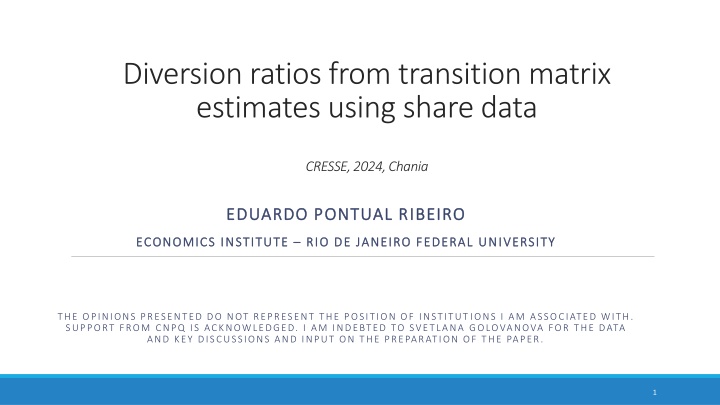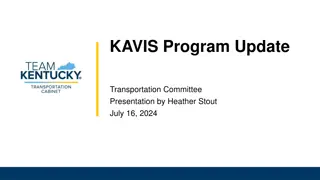
Estimating Diversion Ratios and Transition Matrix Dynamics
Learn about estimating diversion ratios from transition data, using market shares for antitrust analysis. Explore the use of ecological forecasting methods to estimate transition matrices and understand the dynamics of market shares in logit demand models.
Download Presentation

Please find below an Image/Link to download the presentation.
The content on the website is provided AS IS for your information and personal use only. It may not be sold, licensed, or shared on other websites without obtaining consent from the author. If you encounter any issues during the download, it is possible that the publisher has removed the file from their server.
You are allowed to download the files provided on this website for personal or commercial use, subject to the condition that they are used lawfully. All files are the property of their respective owners.
The content on the website is provided AS IS for your information and personal use only. It may not be sold, licensed, or shared on other websites without obtaining consent from the author.
E N D
Presentation Transcript
Diversion ratios from transition matrix estimates using share data CRESSE, 2024, Chania EDUARDO PONTUAL RIBEIRO EDUARDO PONTUAL RIBEIRO ECONOMICS ECONOMICS INSTITUTE INSTITUTE RIO DE JANEIRO FEDERAL RIO DE JANEIRO FEDERAL UNIVERSITY UNIVERSITY THE OPINIONS PRESENTED DO NOT REPRESENT THE POSITION OF INSTITUT IONS I AM ASSOCIATED WITH. SUPPORT FROM CNPQ IS ACKNOWLEDGED. I AM INDEBTED TO SVETLANA GOLOVANOVA FOR THE DATA AND KEY DISCUSSIONS AND INPUT ON THE PREPARATION OF THE PAPER. 1
Diversion ratios are central in merger analysis. They inform about closeness of competition between firms and can be used in upward pricing pressure (UPP) indicators or merger simulation. (Valetti and Zenger 2021, e.g.) Motivation and goals Estimating diversion ratios requires a full demand system estimation for (relevant) market firms/products, with stringent data requirements (prices, quantities and instruments) (Davies and Garc s, 2010) . Alternatively, market share data only can be used to calculate diversion ratios at the cost of using a very restrictive demand system and an assumption about an outside good. 2
Less stringent data requirements and demand structure use win/loss (churning) data, in a transition matrix context. Recently, Qui et al (2024) (i) presented a demand model that yields a transition matrix pattern for unconditional market shares and rationalize the use of win/loss data; (ii) provide correct diversion ratio estimates from transition data. Conlon and Mortimer (2024) explore estimation methods to fill missing win/loss data when only available for some firms. Motivation and goals . 3
Given this renewed interest in diversion ratios from transition data, we propose the use of estimation methods from the ecological forecasting to estimate a transition matrix using (unconditional) market shares. Motivation and goals Such market shares are often available when demand estimation data is not, with potential large use in antitrust analysis. . 4
A (Markovian) transition matrix is a statistical model that is used to describe discrete distribution dynamics, under the assumption of single lag relevance. Methods Discrete choice models present market shares as probability distributions. Qui et al (2024) rationalizes the transition matrix dynamics for market shares in a logit demand model with switching costs. . 5
Let si=qi/(q0+q1+q2) with jsjt=1 and St=[s0t, s1t, s2t]T. (unconditional distribution of market shares). si be the (output) share of good I, Methods The transition matrix is a logical tool that updates the market share unconditional distribution St= St-1for all t=1, ?11 ?21 ?01 ?12 ?22 ?02 ?10 ?20 ?00 ?1? ?2? ?0? ?1? 1 ?2? 1 ?0? 1 = (1) with the restriction that j jk=1 (columns add to one). In discrete choice models jk=P(choice j at time t | choice k at time t-1). . 6
Two simple methods could be used to estimate the unknown parameters jk. A simple VAR or a VAR with restrictions as in LAIDS demand systems. As jsjt=1, for the case of three products s0t-1=1-s1t-1- s2t-1. Methods s1t= 11s1t-1+ 12s2t-1+ 10+ 3t s2t= 21s1t-1+ 22s2t-1+ 20+ 2t s0t= 01s1t-1+ 02s2t-1+ 00+ 1t where e.g., 11=( 11- 10), 12=( 12- 10), 21=( 21- 20), 22=( 22- 20), 10= 10, 20= 20and so forth. Original parameters may be recovered using 11= 11+ 10, 12= 12+ 10and accordingly for other parameters. . Estimating (6) as an unrestricted VAR is straightforward, but may generate parameters incompatible with a transition matrix. Parameter inequalities restrictions to estimate the model is not commonly included in econometric softwares. 7
Estimating the model as an unrestricted VAR is straightforward, but (i) incompatible with a transition matrix; (ii) does not consider that residuals add to zero in a date. Parameter inequality restrictions are not commonly included in econometric software. may generate parameters Methods Alternatively, LAIDS demand type practice (Berndt, 1991, Davies and Garc s, 2010), with NLSURE methods could be used. This entails omitting one of the equations, as residuals add to one. s1t= 11s1t-1+ 12s2t-1+ 10+ 1t s2t= 21s1t-1+ 22s2t-1+ 20+ 2t . NLSURE parameter restrictions such as using as actual parameters such as cj0=exp(bj0)/[1+exp(bj0)] 8
We use the lphom method Pavia and Romero (2022), Romero (2020), that converts the model to quantities, instead of shares and uses lead absolute deviation to estimate the system. q1t= 11q1t-1+ 12q2t-1+ 10q0t-1+ 1t q2t= 21q1t-1+ 22q2t-1+ 20q0t-1+ 2t q0t= 01q1t-1+ 02q2t-1+ 00q0t-1+ 1t Methods solving Min i j| ij|. It is known that that this is a linear programming model (e.g. Koenker and Bassett, 1978), where inequality restrictions are more easily included. Standard errors are calculated (i) using bootstrap in the original R function; (ii) using a jackknife, leave one out method (Bianchi and Salvani, 2015). . Data requirements: large enough sample for asymptotics to work under parameter stability, 9
Qiu et al. (2024) explain the different diversion rations that may be calculated from win/lose data estimated probabilities (i.e., the ij). Diversion ratios are defined as Dkj=- qj/ qk, induced by a price change in product k. Methods from transition matrix coefficients to diversion ratios If one only has win/lose data, the estimate is DkjL= kj/(1- kk) The actual estimate from the full transition matrix is ????????,? 1 ? (1 ???)?????,? 1 ? ???,?= Or ??? ??? (1 ???)?????,? 1 (1 ???)?????,? 1 ? ???,?= ??? = 1 ??? 1 ??? ? ? And share diversion, based on a Logit model, with no adjustment costs . DkjS=sj/(1-sk) 10
Methods from transition matrix coefficients to diversion ratios DkjLomits the simultaneous effects of other transitions, once the shock appears. So, it may be larger or smaller than the true diversion, clarifying an earlier results by Chu and Schwarz (2016). The actual diversion changes over time as it is based on one step ahead forecast from the transition matrix. If there are no adjustment costs, we should have unconditional probabilities equal to conditional probabilities and Dkj,tis constant and simplifies to DkjLand DkjS. We can think DkjSas a stable long run solution for the estimated transition matrix coefficients. . 11
We estimate the transition matrix for online travel agencies (OTAs) in Russia in 2023. Daily data on visits was collected from Jan 1st, 2023 to Dec. 31st, 2023. Data The outside good was set such that the total market is the total maximum number of visits in a day over the year (in the summer). The results are robust to changing the size of the market. We consider the seven largest sites, that have more than 98% of visits. The Russian case is interesting as there are many local OTAs and the market tend to be less concentrated than in other countries. Purchases in OTAs may exhibit persistence as (i) OTAs often have bonuses for repeated purchases; (ii) while easy to multihome in web browsers, the extensive use of apps create habits in OTA use. . 12
Table 4. Platforms considered in the estimates Descriptive Statistics Platform services, other than accommodation booking air tickets, car rental, taxi booking, tour booking 2023 Jan. visits share, % Geographic coverage Website language Worldwide (198 countries) 43 Platforms in the sample Booking.com 12.5 languages Worldwide (220 countries) Worldwide (no information on the countries) 24 Ostrovok.ru No 21.7 languages air, railway and bus tickets; tour booking air, railway and bus tickets; tour booking; car rental 16 Travel.yandex.ru 34.0 languages Worldwide (232 countries) 9 Onetwotrip.com 5.7 languages Focus on Russia and CIS countries (47 countries total) Russia, Abkhazia, Belarus and Georgia Worldwide (64 countries) Sutochno.ru Russian, English No 10.3 Tvil.ru No Russian 6.4 . 101hotels.com No Russian 7.6 13
Table 2 - Parameter Estimates Transition Matrix Seven largest Online Travel Agencies Russia 2023 (as %) Previous Date Platfom visited Current date platform visited (below) 39.8 7.1 4.7 [39-41.9] [5.5-7.2] [3.6-5.5] 28.6 47.2 9.4 [25.2-29.8] [46.4-48.8] [9.2-10.7] 4.6 26.9 38.4 [2.5-6.6] [26.4-29.1] [36.7-39] 0.0 8.4 5.2 [0-0] [8-9] [4.7-5.7] 10.6 2.9 4.9 [10.5-11.5] [2.3-3] [4.8-5.2] 0.0 3.3 2.5 [0-0] [2.4-3.6] [2.2-3.2] 0.0 4.3 14.8 [0-0] [3.2-4.7] [14.3-15.1] 16.4 0.0 20.2 [13.7-20.1] [0-0] [19.4-20.9] Note: estimates from model (2). 10% confidence intervals in brackets, based on leave one out jackknife estimates. Columns add to 100. Current date platform visited (below) Previous Date Platfom visited Travel Travel Yandex Yandex 4.7 [3.6-5.5] 9.4 [9.2-10.7] 38.4 [36.7-39] 5.2 [4.7-5.7] Booking Booking Ostrovok Ostrovok Sutochno Sutochno Onetwotrip Onetwotrip Tvil 101Hotels 101Hotels Other Tvil Other 39.8 [39-41.9] 28.6 [25.2-29.8] 4.6 [2.5-6.6] 0.0 [0-0] 7.1 0.0 [0-0] 2.8 [1.2-2.9] 34.9 [33.9-36] [40.9-49.5] 51.6 [51.3- 52.9] 3.7 [3.6-3.7] 2.3 [2.3-2.8] 4.6 [4.3-6.1] 8.6 0.0 [0-0] 14.0 7.8 1.6 0.0 [0-0] 2.8 [1.2-2.9] 34.9 [33.9-36] 51.6 [51.3-52.9] 3.7 [3.6-3.7] 2.3 [2.3-2.8] 4.6 [4.3-6.1] 0.0 [0-0] 0.0 [0-0] 8.6 0.0 [0-0] 14.0 7.8 1.6 Base Estimates - lphom Booking Booking [6.9-15.8] 0.0 [0-0] 47.4 [40.9-49.5] 20.6 [18.3-22] 23.4 [22.9-24] 0.0 [0-0] 0.0 [0-0] 0.0 [0-0] 0.0 [0-0] [7.3-8.2] 19.3 [17.5-19.9] 24.3 [23.4-27.4] 13.2 [11.6-14.2] 0.6 [0.2-0.7] 4.8 [3.9-5.3] 29.9 [28.9-30.8] 0.0 [0-1.1] 0.0 [0-1.1] [1.6-1.7] 2.2 [2-2.3] 4.5 [4.4-4.6] 0.0 [0-0] 0.0 [0-0] 0.0 [0-0] 0.0 [0-0] 91.8 [91.5-91.9] 91.8 [91.5-91.9] [5.5-7.2] 47.2 [46.4-48.8] 26.9 [26.4-29.1] 8.4 [8-9] [6.9-15.8] 0.0 [0-0] 47.4 [7.3-8.2] 19.3 [1.6-1.7] 2.2 [2-2.3] 4.5 [4.4-4.6] 0.0 [0-0] Ostrovok Ostrovok [13.2-17.5] 3.7 [0.7-5.7] 17.7 [15.7-18] 0.0 [0-0] 64.6 [63.8-64.9] 0.0 [0-0] 0.0 [0-0] 0.0 [0-0] [13.2-17.5] [17.5-19.9] 3.7 [0.7-5.7] 17.7 [15.7-18] 24.3 Travel Yandex Travel Yandex [23.4-27.4] 13.2 [11.6-14.2] 20.6 [18.3-22] Sutochno Sutochno Onetwotrip Onetwotrip 10.6 2.9 [2.3-3] 3.3 [2.4-3.6] 4.3 [3.2-4.7] 0.0 [0-0] 4.9 23.4 [22.9-24] 0.0 [0-0] 0.0 [0-0] 0.0 [0-0] 64.6 0.6 0.0 [0-0] 0.0 [0-0] 0.0 [0-0] [10.5-11.5] 0.0 [0-0] 0.0 [0-0] 16.4 [13.7-20.1] [4.8-5.2] 2.5 [2.2-3.2] 14.8 [14.3-15.1] 20.2 [19.4-20.9] [0.2-0.7] 4.8 [3.9-5.3] 29.9 [28.9-30.8] Tvil Tvil [63.8-64.9] 0.0 [0-0] 101Hotels 101Hotels . Other Other 14
Figure 2. Actual and predicted market shares of OTA platforms in Russia, 2023 .25 .1 .08 .2 Base Estimates -lphom .15 .06 .04 .1 .05 .02 0 100 200 time 300 400 0 100 200 time 300 400 Booking Ostrovok QtOstr.1 X2.1 QtBook.1 X1.1 .3 .35 .3 .2 .25 . .2 .1 .15 .1 0 0 100 200 time 300 400 0 100 200 time 300 400 Travel Yandex Sutochno QtSut.1 X4.1 QtTY.1 X3.1 .06 .2 .05 .15 15 .04 .1 .03 .05 .02 .01 0 0 100 200 time 300 400 0 100 200 time 300 400 QtOnetwo.1 X5.1 Onetwotrip Tvil QtTvil.1 X6.1 .2 .15 .1 .05 0 0 100 200 time 300 400 101Hotels Qt101H.1 X7.1 Note: blue line are market shares, calculated including the outside good. Red line represent predicted shares.
Figure 2. Actual and predicted market shares of OTA platforms in Russia, 2023 .25 .1 .08 .2 .15 .06 .04 .1 .05 .02 0 100 200 time 300 400 0 100 200 time 300 400 Booking Ostrovok QtOstr.1 X2.1 QtBook.1 X1.1 .3 .35 .3 .2 .25 .2 .1 .15 .1 0 0 100 200 time 300 400 0 100 200 time 300 400 Travel Yandex Sutochno QtSut.1 X4.1 QtTY.1 X3.1 .06 .2 .05 .15 .04 .1 Base Estimates -lphom .03 .05 .02 .01 0 0 100 200 time 300 400 0 100 200 time 300 400 QtOnetwo.1 X5.1 Onetwotrip Tvil QtTvil.1 X6.1 .2 .15 .1 . .05 0 0 100 200 time 300 400 101Hotels Qt101H.1 X7.1 Note: blue line are market shares, calculated including the outside good. Red line represent predicted shares. 16
Table 3 Diversion Ratios Seven largest Online Travel Platforms Russia, 2023 From column Site Booking Ostrovok Yandex Booking 0.14 0.07 Ostrovok 0.27 0.20 Travel Yandex Sutochno 0.05 0.11 0.20 Onetwotrip 0.08 0.05 0.07 101Hotels 0.02 0.07 0.04 Tvil 0.06 0.10 0.13 Aggregate Diversion Note: based on Table 2 and Equation (3). Aggregate diversion is the sum of column diversion rates but for the outside/other alternative. Base Estimates lphom Diversion Ratios Travel Sutochno Onetwotrip 101Hotels Tvil 0.04 0.17 0.14 0.17 0.03 0.29 0.07 0.19 0.21 0.32 0.47 0.07 0.11 0.11 0.96 0.35 0.15 0.02 0.07 0.89 0.24 0.29 0.02 0.08 0.95 0.40 0.14 0.04 0.04 0.87 To row Site 0.69 0.79 0.71 . 17
Table 4 Loss Diversion Ratios Online Travel Platforms Russia, 2023 Booking Ostrovok Yandex Booking 0.13 0.08 Ostrovok 0.48 0.15 Travel Yandex 0.08 0.51 Sutochno 0.00 0.16 0.08 Onetwotrip 0.18 0.05 0.08 101Hotels 0.00 0.06 0.04 Tvil 0.00 0.08 0.24 Aggregate Diversion Note: based on Table 2 and loss diversion (Dkj= jk/(1- kk)). where k is the column platform and j is the row platform. Aggregate diversion is the sum of column diversion rates but for the outside/other alternative. From column Site Travel Sutochno Onetwotrip 101Hotels Tvil Base Estimates lphom Diversion Ratios Loss diversion and share diversion 0.00 0.06 0.72 0.08 0.05 0.10 1.00 0.11 0.00 0.62 0.27 0.00 0.00 1.00 0.00 0.40 0.10 0.50 0.00 0.00 1.00 0.11 0.28 0.35 0.19 0.01 0.07 1.00 To row Site 0.73 1.00 0.67 Table 5 Share based Diversion Ratios Online Travel Platforms Russia, 2023 Booking Ostrovok Yandex Booking 0.05 0.06 Ostrovok 0.11 0.13 Travel Yandex 0.18 0.19 Sutochno 0.08 0.08 0.09 Onetwotrip 0.03 0.03 0.03 101Hotels 0.03 0.04 0.04 Tvil 0.05 0.05 0.06 Aggregate Diversion Note: based on Table 1 market shares, using average shares Dkj=sj/(1-sk), where k is the column platform and j is the row platform. Aggregate diversion is the sum of column diversion rates. Market shares used: Booking: 4.9%, Ostrovok: 10.6%, Travel Yandex: 16.7%, Sutochno: 7.2%, Onetwotravel: 2.5%, Tvil: 3.3%, 101Hotels: 4.6%, outside option: 50.2% From column Site Travel Sutochno Onetwotrip 101Hotels Tvil 0.05 0.11 0.18 0.03 0.04 0.05 0.46 0.05 0.11 0.17 0.07 0.03 0.05 0.49 0.05 0.11 0.17 0.07 0.03 0.05 0.48 0.05 0.11 0.17 0.08 0.03 0.03 0.47 To row Site . 0.47 0.44 0.40 18
Model tends to predict very well, as expected for an autoregressive model with moderate persistence. Diagonal (stay) conditional probabilities tend to be the largest in a column. Empirical Results Estimates often reach the zero lower bound, particularly for the smaller OTAs and the outside good. Loss Diversion Ratios have very high aggregate diversion, suggesting that visitors always consume when switching. The picture is more nuanced with the correct diversion diversion may be misleading in the closeness of competition. formula. Shares based . Market competition. leader seem more isolated from 19
Table A1 Transition Matrix based on unrestricted VAR model From Column Site booking ostrovok TY sutochno onetwotrip tvil 101Hotels outside booking ostrovok travel_yandex sutochno onetwotrip tvil 101Hotels outside Note: based on VAR as in system (6). Yellow indicates parameter out of bounds. 0.298 0.075 0.121 -0.071 0.070 -0.043 -0.028 0.423 0.036 0.397 0.122 0.177 0.003 0.060 0.014 0.809 -0.009 0.001 0.317 -0.060 0.029 0.007 0.085 0.370 0.025 0.118 0.434 0.465 0.043 0.066 0.128 1.279 0.393 0.490 1.003 0.925 0.384 0.228 0.324 3.747 0.129 0.411 0.232 0.329 0.058 0.472 0.107 1.737 0.081 0.161 0.166 0.068 0.003 0.053 0.227 0.758 0.024 0.037 0.046 -0.008 0.004 -0.002 0.001 0.102 Empirical Results Other methods Table A2 Transition Matrix based on NLSURE Russia 2023 From Column Site booking ostrovok TY sutochno onetwotrip tvil 101Hotels Outside booking ostrovok travel_yandex sutochno onetwotrip tvil 101Hotels outside Note: based on NLSure system (7). Yellow indicates parameters out of bounds. 0.291 0.052 0.093 -0.139 0.066 -0.062 -0.050 0.699 0.033 0.389 0.112 0.152 0.002 0.053 0.003 0.259 -0.011 -0.004 0.310 -0.076 0.028 0.003 0.077 0.750 0.029 0.131 0.449 0.503 0.045 0.077 0.135 -0.234 0.393 0.490 1.003 0.925 0.384 0.228 0.320 -2.423 0.133 0.423 0.247 0.366 0.060 0.482 0.114 -0.711 0.058 0.126 0.123 0.083 -0.001 0.057 0.227 0.554 0.025 0.040 0.050 0.000 0.004 0.000 0.004 0.881 20
We introduce in the antitrust literature the use of ecological forecast methods from political science to estimate a transition matrix. The method only uses market share data. The observed unconditional probabilities (shares) and estimated conditional probabilities are inputs required to calculate diversion ratios. The method provided more coherent results than other methods in our application. Concluding comments . 21
We introduce in the antitrust literature the use of ecological forecast methods from political science to estimate a transition matrix. The method only uses market share data. The observed unconditional probabilities (shares) and estimated conditional probabilities are inputs required to calculate diversion ratios. Recently Qiu et al (2024) showed how to calculate diversion ratios from transition data. We suggest a method that uses simpler data. Concluding comments . 22
The method provided more coherent results than other methods in our application. The estimated transitions show persistence that is compatible with the underlying model switching costs. The results show that share diversion may be misleading in the closeness of competition ranking. Concluding comments Directions of future research would be using simulated data to see the ability of the method to recover conditional probabilities from marginal probabilities in the context of a demand model. . 23
Thank you www.ie.ufrj.br/gdec eribeiro@ie.ufrj.br 24





















